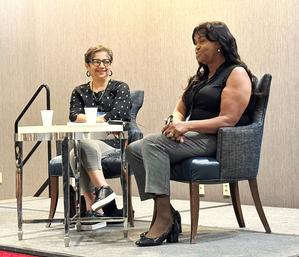 For the opening keynote at the New England Independent Booksellers Association Fall Conference in Newton, Mass., last week, Madhulika Sikka, v-p and executive editor, Crown Books, was in conversation with Tamara Lanier, whose upcoming book, From These Roots: My Fight with Harvard to Reclaim My Legacy, she edited.
For the opening keynote at the New England Independent Booksellers Association Fall Conference in Newton, Mass., last week, Madhulika Sikka, v-p and executive editor, Crown Books, was in conversation with Tamara Lanier, whose upcoming book, From These Roots: My Fight with Harvard to Reclaim My Legacy, she edited.
Lanier is a retired Connecticut chief probation officer and first-time author who recounts in her book, which will be published in January, how her late mother, "a great storyteller," was the keeper of her family's stories. In her last years, Lanier's mother especially emphasized the family's African and Indian roots, and told stories about her grandfather, who was a slave, and especially Lanier's great-great-great grandfather, Papa Renty, who was captured in the Congo, taught himself to read, taught other slaves how to read (dangerous because it was illegal), and was the main carpenter for the South Carolina family that owned him. Lanier remembers long private moments with her mother, and "when she told stories, a peace came over her that I can't describe." When she was sick and dying, Lanier's mother urged Lanier to write the stories down, to do a genealogical tree, "to always remember and never forget."
 |
|
| Madhulika Sikka (l.) and Tamara Lanier | |
Lanier recalled that at that time, about 2010, she had trouble doing research but made a fortuitous connection with a computer-adept local acquaintance. Online he quickly found a picture of Papa Renty--a daguerreotype taken before the Civil War by Louis Agassiz, a Swiss scientist who was a professor of geology and zoology who became a Harvard professor and devoted much of his work there trying to prove that blacks were inferior to whites. Agassiz took a series of daguerreotypes of enslaved people in the South that included images of Papa Renty, labeled "Renty, Congo," as well as his daughter Delia, that are held in Harvard's Peabody Museum of Archaeology and Ethnology. When she first saw online the image of her great-great-great-grandfather, Lanier said, "I knew it was the man I had heard stories about my entire life. I had feelings of familiarity and kinship."
Lanier went to Harvard to see the daguerreotype, but "I was not warmly welcomed," she said. She wanted to share with the museum "who Renty was so they could incorporate it into their storytelling," but she was rebuffed. She also wanted them to take the frame around the image off so she could see what was covered, particularly Papa Renty's hands, but was rebuffed again. She asked, as a direct descendant, to have the images, to no avail. And when Harvard used an image of Papa Renty on a publication and at a conference, she sued--both to take possession of the images as well as for emotional duress.
The battle in Massachusetts courts continues, and while dealing with Harvard has been a long ordeal, Lanier has made wonderful connections with the descendants of the people who enslaved her ancestors as well as the person who used them to try to prove racist theories, finding the kind of humanity and understanding that she had hoped to find with staff at the Peabody Museum. Through a member of the Taylor family--a descendant of those who had owned Papa Renty--Lanier came to visit Dr. Edmund Taylor, 98 years old at the time, who was the keeper of his family's stories. Dr. Taylor hosted Lanier in his home, where she sat at a table and ate from dishes handcarved by Papa Renty. "I felt an ancestral pride I can't describe," Lanier said.
Dr. Taylor "had so much information and insight," Lanier said. His stories were similar to her mother's stories, but told from a different perspective. "He wanted me to know that he was doing something to atone for what he felt were the sins of his ancestors." Taylor family members have become good friends of Lanier, and have supported her in her fight against Harvard.
In the same striking way, Lanier has contacted descendants of Louis Agassiz in both the U.S. and Switzerland, visited with them, and become good friends. They, too, have supported her in her battles. Lanier remembered hesitating before reaching out to them, worried that Agassiz's hate would have been passed on through the generations. But no. As she said, "We are family." --John Mutter

